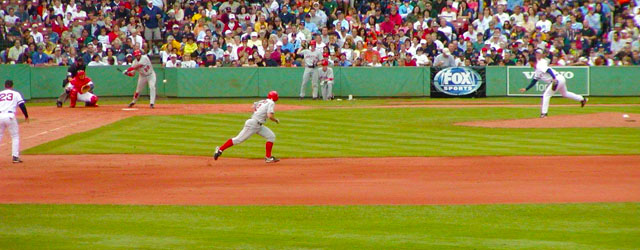(photo credit: mlb.com)
Most coaches and players have heard of quality at bats. Why are they so important? Focusing on QABs is about controlling what you can control, with a team-first focus, rather than a me-first focus.
Hitting is challenging, which is why we love it, but when a hitter is consumed with stress about his own stats, fearful of future performances repeating past failures, or distracted by expectations, hitting has become nearly impossible.
A focus on QABs allows a hitter to stay focused on simplifying the game.
No one on base, first inning? I should be focused on reaching base, nothing more. Get a good pitch to hit, and I will maximize my chances of making a HARD CONTACT.
Developing toughness in practice, and the mechanical savvy to hold your ground on an inside pitch, allows a hitter to react appropriately in-game and take an HBP.
Acquiring plate discipline in front toss and batting practice allows a hitter to avoid weak contact more often, see more pitches, and improve his chances of coaxing a BB.
After a foul ball and a close call for strike two, we find ourselves down 0-2. Battle your way from 0-2 to seeing 4+ pitches! You have just flipped the script on the pitcher! Now, many pitchers are begging to get any ball put in play, as they don't want their pitch count to continue to skyrocket.
Any executed bunt, slash, hit and run or run and hit is a QAB! These are huge skills to master. Executing these skills keeps an opposing defense, pitcher and manager on the defensive, and alleviates the pressure to get hit after hit by only swinging against good pitchers.
(photo credit: The Full Windup)
With a runner at second base and 0 outs, it's great to advance the runner from second to third, but this is situational. I should not give away at-bats in an effort to manipulate and push the ball back side. Our offensive goal is to score as many runs as possible each inning, not just one run, unless we are in a "tight and close" scenario.
Any time you get an RBI while making an out, that's a QAB. Let's not focus on perfection. An RBI ground out may not be ideal, but it's quality. These aren't called Perfect At Bats! Of course, hitters must be taught which situations ask for them to potentially sacrifice a more aggressive approach for something simpler that more consistently gets the run home. Most situations with a runner at third and less than two outs create this QAB opportunity.
Hits aren't QABs, but 2-strike hits sure as heck are. To get a two-strike hit, a hitter must take advantage of a mistake or fight his way to getting a pitch he can handle to score the run.
Lastly, any at-bat that ends with 8+ pitches is a QAB, regardless of the result. The average number of pitches per plate appearance in MLB in 2015 was 4.30. Having an 8 pitch AB has a similar impact on a pitcher to having faced an extra hitter. The more of these high pitch ABs we can put together, the faster we can get into the bullpen. And with the exception of at the big league level, bullpen pitchers are their because they aren't as skilled as starters!
Be a great teammate! Focusing on ways you can help your team win will undoubtedly free you up emotionally to have more aggressiveness, confidence and commitment at the plate!
Of course, we can't just succeed in the game, unless we practice how the game will challenge us. Compete with your teammates in the cage by envisioning and communicating what situations you have!


No comments
Post a Comment